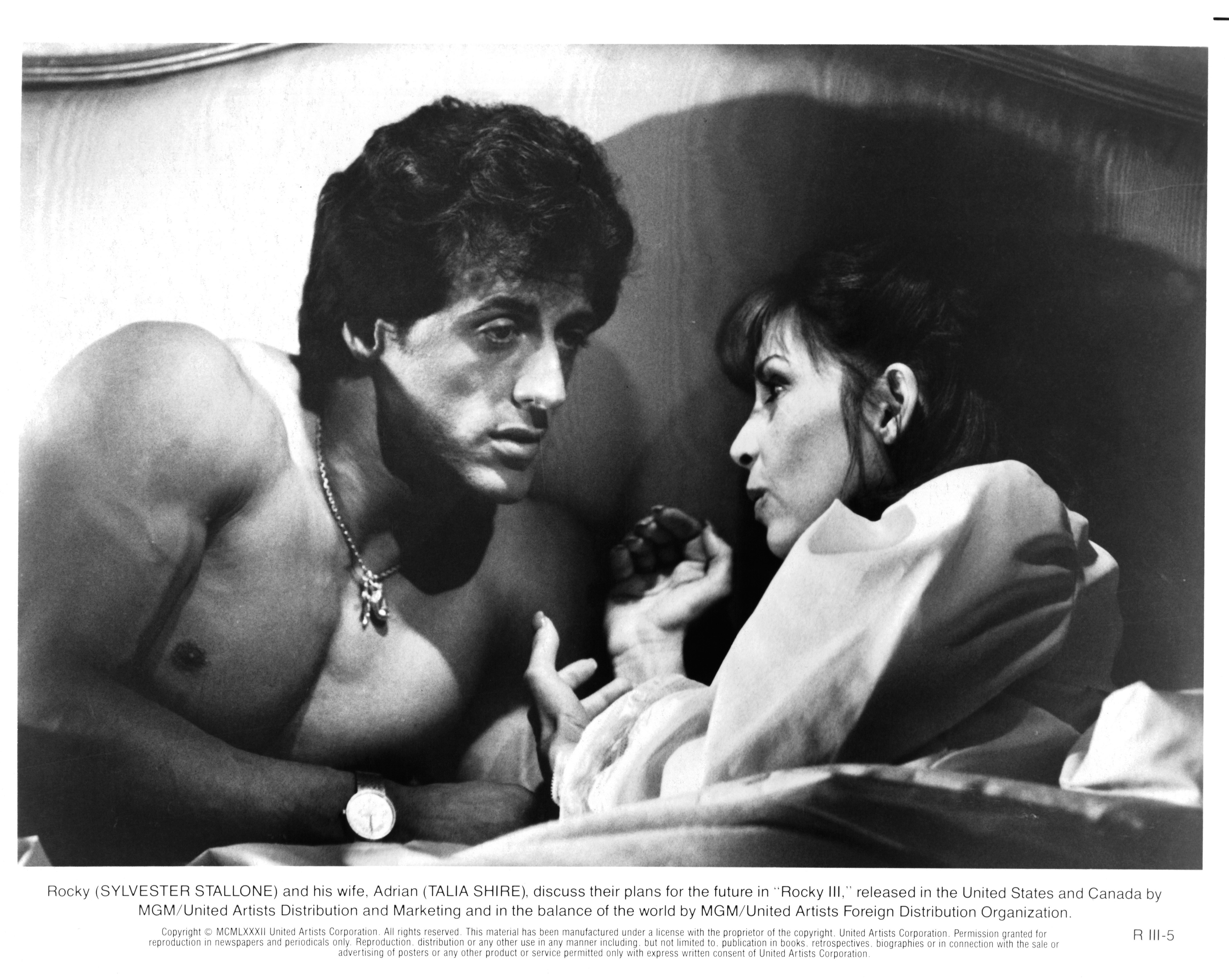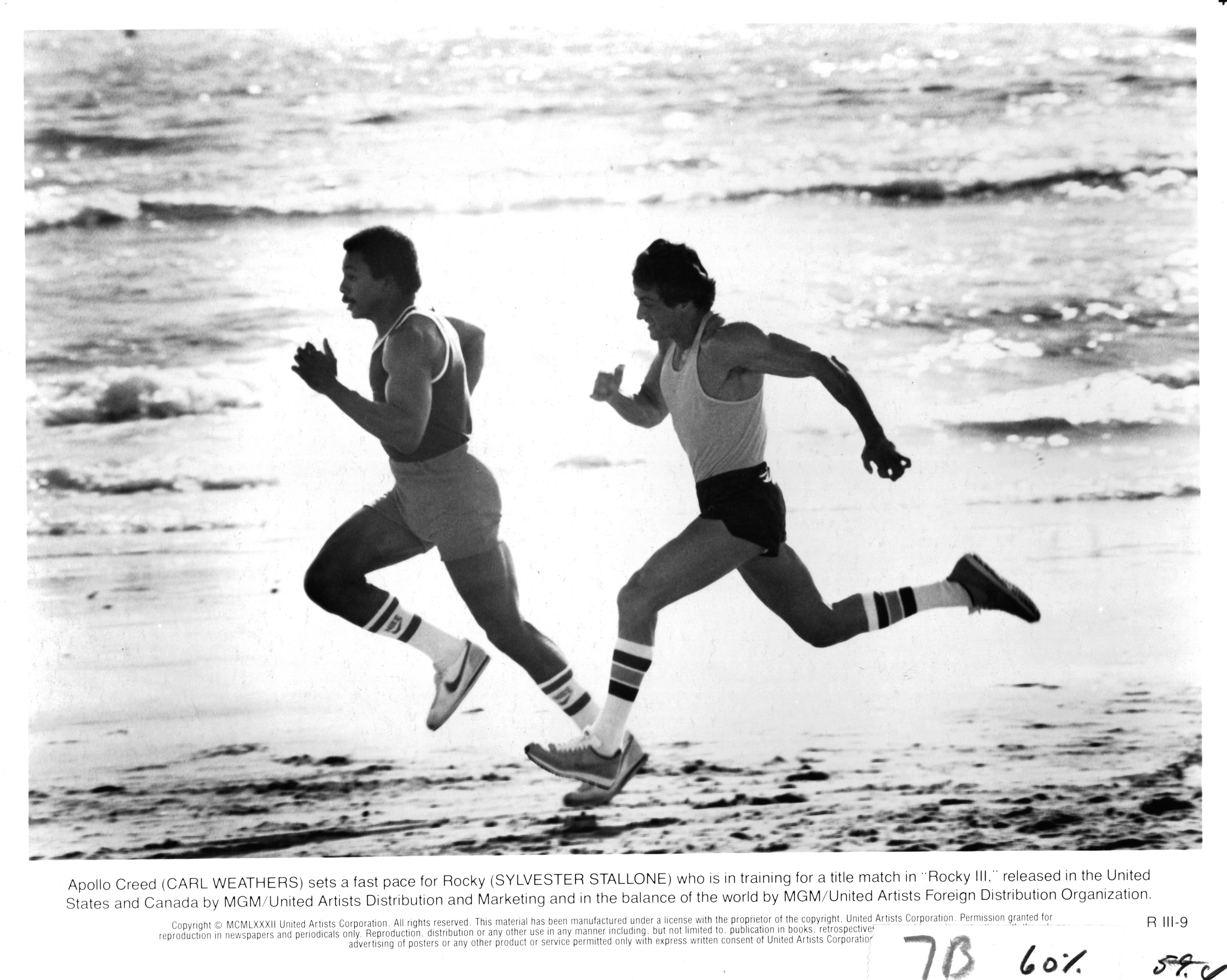
Rocky is the long-shot character drama that could. Rocky II is the rematch. But Rocky III is the franchise turning point. It’s also kind of terrible.
Rocky III is best remembered as the one with Mr. T, the one with Hulk Hogan, or the one where Rocky Balboa and Apollo Creed become bros on the beach. Take your pick.
Released the same year as Rambo: First Blood, the two Sylvester Stallone vehicles start to bleed into each other. (Rocky IV takes on the Soviet Union. Guess who Stallone fights in Rambo III?) Rocky’s underdog story becomes an action series ‘80s onward, trading the beating heart of the original for ham-fisted melodrama punctuated by a cartoon-y villain.
In retrospect, Rocky Balboa’s third bout is hardly the worst, though it seemed that way at the time. Much of what we know of the franchise formula is crystallized in Rocky III – grudge matches, meatier opponents, sweatier training montages, and a back-to-basics game plan. It also cemented “Eye of the Tiger” into the series’ iconography. While Rocky III is a step down from its former greatness, it is somehow its own cheesy monument 40 years running, turning what was meant to be the end of the series into a turning point for a franchise still going strong today.
The sad-sack underdog has become a winning icon. Early on, Rocky Balboa is presented with a statue of himself on very the steps he made famous – a surreal victory lap. Cameras and product endorsements once made him uncomfortable. In the opening montage, he’s on the cover of magazines, doing commercials for American Express, and appearing on The Muppet Show. Rocky’s first fight in the movie against Hulk Hogan’s Thunderlips is a Looney Tunes cat-and-mouse chase around the ring. A hungry challenger sees past the glitz and glam: The Italian Stallion lost his way.
“The worst thing happened to you that could happen to any fighter… you got civilized,” Rocky’s trainer Mickey (Burgess Meredith) tells the heavyweight champ. Rocky’s earned his fame and fortune, but now he has something to lose. The setup poses honest questions about the ramifications of victory as he contends with his own greatness.
After two movies, personal victories aren’t enough for Stallone. He still wants the drama, but it’s no longer the street-level, working-class hardship that made the first two movies so relatable and compelling. Rocky III is all about the press conference beef where the poster rivalry is an actual battle between good and evil. It ditches reality for Pay-Per-View fantasy, and the franchise becomes a hero’s journey toward winning, not the underdog’s journey where none of that mattered.
The movie wants to bring Rocky back to underdog status by crippling him with insecurity and compounding his loss to Mr. T’s Clubber Lang with the actual loss of Mickey. It’s heavy-handed melodrama, but Stallone’s aw-shucks performance nonetheless sells the moment. He wasn’t afraid to cry at this stage in his career, and this willingness to give Rocky’s vulnerable side just as much screen time as his pecs is what makes Rocky III an endearing swing for the fences, even if it stumbles.
Clubber Lang’s larger-than-life persona ensured future rivals would only get bigger and badder. Mr. T had never acted before, and that rawness on camera translates into a rage and resentment that could plausibly unseat Rocky. A gruff contrast from suave Apollo Creed and the Greek statue of Ivan Drago, Lang is all swagger and bravado, stumping Rocky in a flurry of words at every turn. It’s in this mean streak that Mr. T’s catchphrase, “I pity the fool” was born. Mr. T was meant to be the final punctuation in Rocky Balboa’s story. He inadvertently helped the franchise go the distance.
Stallone wants a bare-bones grudge match, so the script paints Clubber Lang as a comic book villain deserving of comeuppance. He’s not above ambushing Rocky to publicly goad a challenge and he’s certainly not below cheap shots at his wife. This builds up their match, but it comes at the cost of the franchise’s heart.

The trick of the first Rocky is that it’s a stealth love story. Rocky is about a guy who wants to matter in the world, then realizes he just wants to matter to one person. Rocky and Adrian’s love story, sadly, is a casualty alongside Mickey. Talia Shire has less to do as the series goes on. Rocky III, at the very least, solidifies her in Rocky’s corner. Once an introvert who couldn’t meet Rocky’s eye and initially disapproved of his rematch with Apollo, now she gets to be the one doling out the pre-fight pep talk.
But what Rocky III loses in Adrian, it gains in another love story coming to the forefront. Years before Predator’s epic handshake, Stallone and Carl Weathers hugged it out in a “dude’s rock” moment on the beach – a cinematic monument of their rivalry-turned-friendship forged in the crucible of the training montage.
In another movie, Apollo would’ve seized an opportunity at a title shot against Clubber. But there’s something heartwarming about instead training his former opponent. He genuinely feels for Rocky’s loss, vowing to help him get back his “eye of the tiger.” It’s through Apollo that the movie truly goes “back to the streets” where this saga began.

The second half of the movie peels back an unexpected layer between Rocky and Apollo. They might’ve been on opposite sides of the ring twice before, but they weren’t nemeses. Rocky just wanted his shot in the universe, while Apollo was contending with his pride and reputation. There’s no need to bury the hatchet between them because there was never a grudge. Boxing brought them together. Perhaps they’ve been friends all along and didn’t know it.
Rocky III is at its best when it emerges as a tale about champs supporting champs. This dynamic lays the emotional foundation for the mentor and trainee relationship between Rocky and Adonis in the Creed films.
Creed III is due out later this year. It’s the first one without Rocky as a mentor, Adonis now free to step into the spotlight without the shadow of its parent franchise. Perhaps Rocky III can finally rest easy. This third bout might’ve been the worst at the time, but Rocky V would come along in due time, so it’s not all bad or that outlandish in retrospect. (Heck, it’s not even the one with the robot.) If you can believe it, Stallone initially wanted Rocky III’s final bout to take place in the Roman Coliseum plus a cameo appearance by the Pope himself. It was all for the best, though that hardly humbled Stallone’s ambitions. By Rocky IV, the franchise would become a political cartoon with Rocky literally beating the U.S.S.R. with his fists.
Epic grudges and more ridiculous premises would arrive soon enough. Another one of Rocky’s trainers will pass away, the soundtracks would become unwieldier, and the training montages more extreme. Rocky III’s cartoonier aspects were ultimately an assurance that the circus would only get more fantastic. In the immortal words of Hulk Hogan: “That’s the name of the game.”







